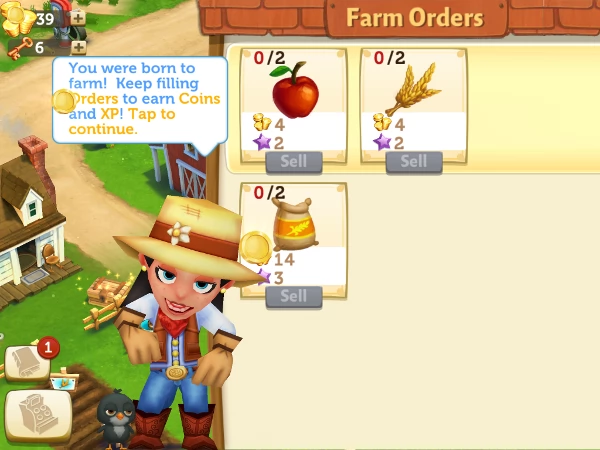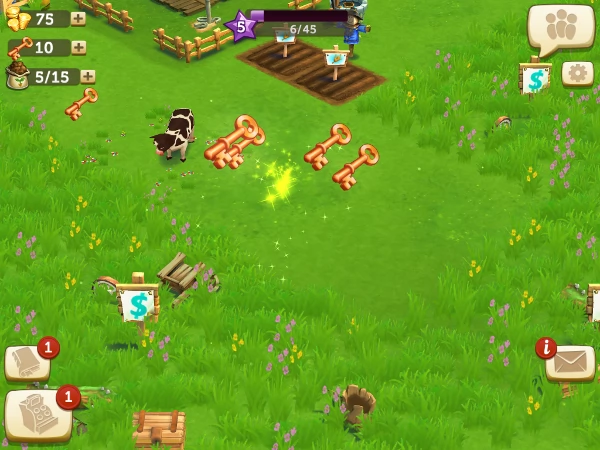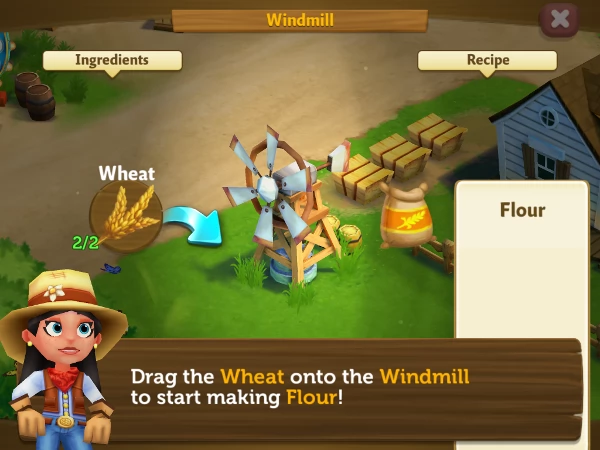Basic Game Play
FarmVille 2: Country Escape Guide
If you are familiar with the main series you will already have a good handle on the game play mech and strategy for play in this new offshoot - if not though, the following basic strategies will really help you a lot:
1. Mind the Quest
The quest book is a very good guide to follow on what to grow and craft, since completing the quests that are on offer accomplish more than just gaining you XP - they also tend to help send you in the best (right) direction in terms of expanding your farm.
Standard play each log in should begin with checking your outstanding quests to see what you need to do to fulfill them.
For example if you log in and check your quest book and find that you have a quest that just needs 3 Herb Butter to be completed, then you know you need to make the resources that are required for that crafting recipe - Butter and Chives basically.
You get the Butter by making Milk and then turning it into Butter. You get the Chives by having your Farm Hands visit and hunt in Grandma's Glade. Once you have the ingrediants you require, you make the Herb Butter in the Dairy. Easy-peasey!

2. Check the Farmer's Market
See if any of your goods have sold - if so, collect the funds received for their sale, and then place any goods you want to sell in the open slot.
Note that resources will sell faster than finished crafting goods - for example Strawberries will sell much quicker than a finished item that contains Strawberries. The reason for that is simple - your mates and neighbors are far more interested in getting the resources that they need to craft those finished goods than they are in buying finished goods!
3. Check the Farm Orders Board
Checking the Board will show you what you have to sell to cycle through the different sale options. You will note that the Board view from the main screen will indicate if you have saleable items via the green tick marks.
Once you open the Board, you will then reveal which of the resources or items you have in storage can be sold for funds and XP.
Bear in mind that the items rotate in like state - so for example if you have no Country Biscuits to sell you can make some and then sell them, and the slot will likely then change to Apple Pies, which you do have to sell - that gets you two sales for your efforts.
Remember that while selling the easier to obtain resources (like Wheat) is generally OK, it is not really a good idea to sell the harder to obtain resources (like Strawberries) in this fashion.
IF you decide that you actually DO want to sell harder to obtain resources, you are better off selling them via the Farmer's Market Stall - so that your mates and neighbors buy them - rather than selling them via the Board, which just sends them into the ether where nobody gets to make use of them!

4. Keep an Eye on Your Inventory
Your Barn will only hold so much in both resources and finished goods - so until you start to expand it -- and that means having the resources to actually do that -- you are going to need to keep a closer eye on the inventory being stored there so that you do not fill it up.
Ideally you want to manage the flow so that you have what you need on hand WHEN You need it, and not simply stockpiled for future crafts - because the latter approach can end up hurting you by blocking storage of the things you actually need in order to progress a craft or quest.
Always bear in mind that you are better off converting a lower-tier resource into a higher tier one than outright selling off the lower resource. For example you are always better off converting Grain into Flour than outright selling the Grain. Just saying.
5. In Place Storage is Preferable to Barn Storage
Whether you know you will need resource X or not, proceeding with its creation - AS LONG AS YOU DO NOT HARVEST IT - gives you the ability to have it ready and waiting when you DO need it, without having to take up valuable storage space in your Barn.
That being the case, getting used to keeping crops at the ready is a smart tactic to adopt.

6. Upgrading Your Tools
Each of the crafting stations can be upgraded to handle larger amounts of the resource for their recipes - for example you can upgrade the Windmill to do x2 or x3 and then that allows you to select the quantity that you want to make, which makes creating larger quantities in single actions possible.
The thing about that is you have to spend Keys to upgrade them - so you want to think carefully about which ones you are more likely to want to have larger capacity for, and act accordingly.
Some simple advice in that regard -- the Windmill and the Oven are obvious choices to upgrade, while the Dairy? Not so much. You will find that you get a lot more use out of the first two, and much less out of the third.
7. Remember the Rule of Conversion when Managing Inventory
The lower tier a resource is, the more of it you tend to have - but remember that converting lower tier resources into the next tier up takes more in units than you will obtain, which makes that an excellent means for managing Inventory.
For example, when you grow two squares of Wheat, you end up with 6 Grain - which you can then covert into Flour at the rate of two-to-one, which will result in less unit quantity in your Inventory.
8. Think in Groups
When you are planning out your resource production capacity, it is smart to think in groups of two (or pairs).
For example having TWO of each type of Crop Square is generally considered to be the optimal number since it allows you to generate sufficient first-tier resources for any second-tier crafting effort.
Having more than two is generally a waste, unless you are boosting XP, in which case it may be helpful to have additional resource producing elements. For example when you are producing Apple Pie in bulk to make XP and funds, having four Apple Trees means that you can do a double-pie run with a single planting session.
Conclusions
The simple and basic method for strategic success in the game is to always keep your inventory in synch with your immediate goals and needs. That may sound very obvious, but the nature of farm sim games is to stock up on resources so it is very easy to fall into the trap of building reserves for resources you do not actually have immediate use for.
When in doubt, craft that resource to the next tier. If you still have too much of a resource, consider selling it off via the Board to convert those extras into XP and funds.
We have questions and answers related to this topic which may also help you: Show all